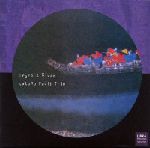Home » Jazz Articles » Album Review » Satoko Fujii Trio: Trace a River
Satoko Fujii Trio: Trace a River
Fujii's trio features longstanding members Mark Dresser on bass and Jim Black on drums. Trace a River is her seventh recording with this line-up; their deep discography reaches back a decade, starting with Looking Out of the Window (Crown, 1998) on up to their previous session, Illusion Suite (Libra, 2004).
A conventional trio in instrumentation, but not approach, these three challenge preconceived notions of soloist and accompanist as they upend stereotypical roles in regards to melody, rhythm and harmony, each member an equal voice. Conversing on a virtually telepathic level, they expound on these sophisticated pieces with episodic drama and fitful invention.
A tuneful amalgamation of the lyrical/introspective bent of post-war pianists like Paul Bley and Keith Jarrett, Fujii's writing for this line-up is among her most compelling. Her compositions resonate with rich harmonic depth and spacious dynamics that provide contrast to dense thickets of activity. Neo-classical themes that resound with romantic impressionism and angular cadences are augmented by dissonant clusters and prismatic chord voicings.
Dresser and Black have been rhythm section partners in countless ensembles; their deep-seated rapport spans a decade. Dresser's strident arco work and Black's effervescent percussive accents offer a range of expression rarely found in most rhythm sections.
Fujii threads myriad styles into her elaborate, multifaceted compositions with an approach that is seamlessly organic. The cinematic "Manta" simmers with pointillist ambience while "A Maze of Alleys" regales with a circuitous fervor that fuses the ebullient lilt of Mozart with the crashing, angular dissonances of Cecil Taylor. "Take Right" transforms from pensive lyricism into riotous abstracted Eastern European dance rhythms while "Kawasemi" modulates from shadowy turmoil into sanguine pop tunefulness reminiscent of the Bad Plus.
The trio often embraces contrasting moods within the space of a song. The title track opens with plangent, harmonic arco bowing from Dresser, accompanied by Fujii's spare chords and Black's scintillating accents. Suddenly, they launch into a coiled unison theme fueled by Fujii's thorny arpeggios, Dresser's thrumming pizzicato and Black's cascading polyrhythms. From this spiraling vortex they open a vista of sonic possibilities to explore before gradually returning to austere beginnings.
"Day After Tomorrow" and "February" feature Fujii solo, plying melodious improvisations ripe with harmonic ingenuity. Alone or with her trio, Fujii reveals a singular voice that effortlessly bridges the accessible with the adventurous. Trace a River offers ample proof of the continued relevance of the venerable piano trio format in the hands a true artist.
Track Listing
Trace A River; Take Right; Manta; A Maze Of Alleys; Day After Tomorrow; Kawasemi; February.
Personnel
Satoko Fujii
pianoSatoko Fujii: piano; Mark Dresser: bass; Jim Black: drums.
Album information
Title: Trace A River | Year Released: 2008 | Record Label: Libra Records
< Previous
Brandi Disterheft: Debut
Next >
Power to the People
Comments
Tags
For the Love of Jazz
 All About Jazz has been a pillar of jazz since 1995, championing it as an art form and, more importantly, supporting the musicians who create it. Our enduring commitment has made "AAJ" one of the most culturally important websites of its kind, read by hundreds of thousands of fans, musicians and industry figures every month.
All About Jazz has been a pillar of jazz since 1995, championing it as an art form and, more importantly, supporting the musicians who create it. Our enduring commitment has made "AAJ" one of the most culturally important websites of its kind, read by hundreds of thousands of fans, musicians and industry figures every month.




















